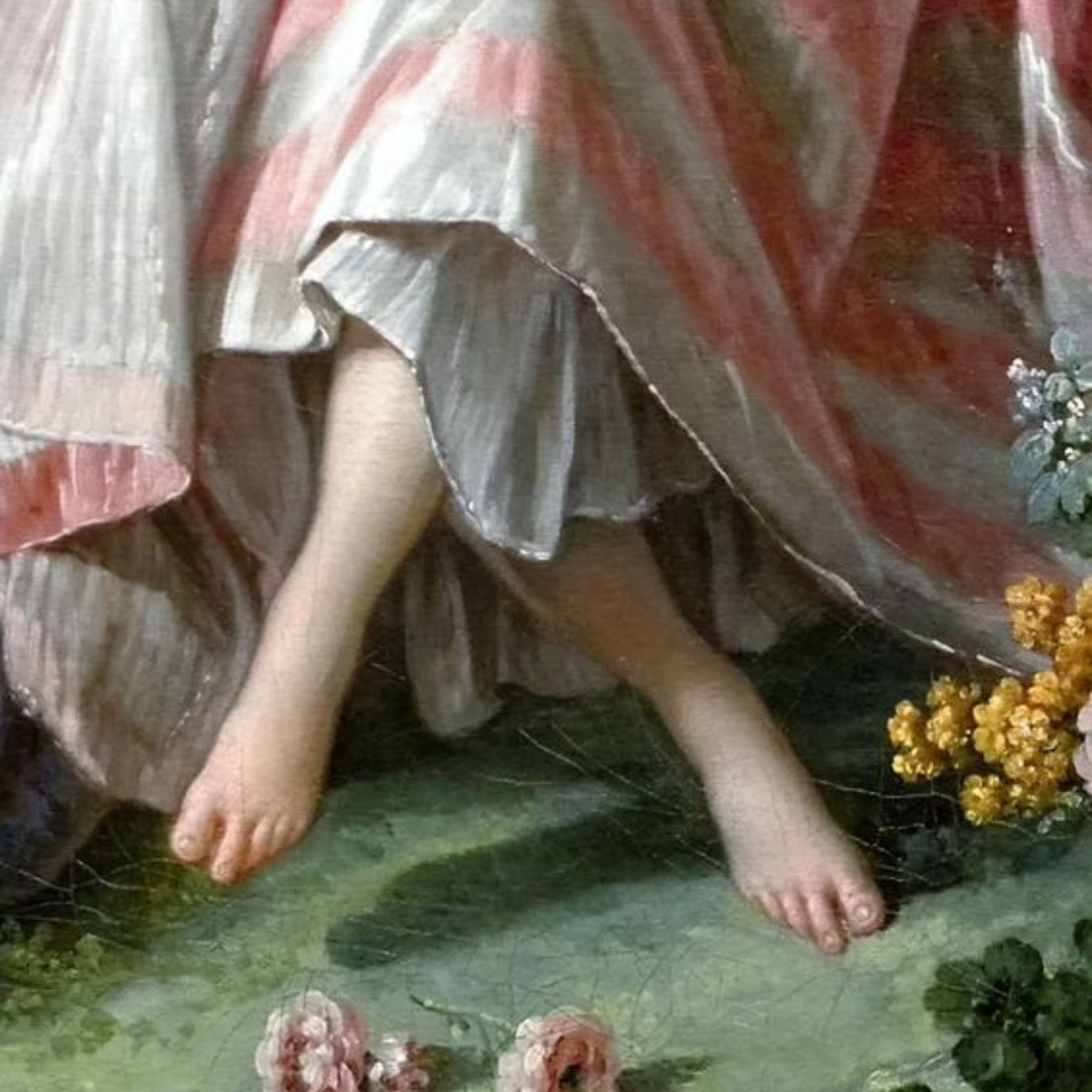
- POPSUGAR Australia
- Living
- The History of the Foot Fetish
The History of the Foot Fetish

As far as fetishes go, a foot fetish feels pretty baseline. You’ve had someone lick your toes during sex before, right? Or at least, like, stroked your feet while they’re going down on you.
Put it this way; while many kinks and fetishes live outside the mainstream world, foot fetishes are pretty commonly talked about.
But why is that?
We’ve definitely seen more mainstream representation of foot fetish than any other fetish. Whether it be countless scenes from the Game of Thrones franchise, to that Sex and the City episode where Charlotte’s shoe fetish is counterbalanced by a shoe store foot fetishist; the depictions have been everything from light-hearted to slightly off-putting to downright horny.
Just recently, a “House of the Dragon” episode displayed the desire of foot fetishism as a way of payment. Queen Alicent appeases the sexual appetite of Lord Larys Strong, by removing her socks and shoes and allowing him to admire her bare feet in exchange for information she needs.
The scene caused a bit of an uproar, with some online fans saying that this fetish depiction was “too far.”
We beg to differ. Not only should people be allowed to be into what they’re into, it’s actually a pretty accurate representation of fetishes throughout history.
“The foot fetish is one of the oldest fetishes that we can trace in history,” says PhD candidate at the University of Melbourne, and the creator of “Kinky History,” Esmé Louise James.
“All the way back to the ancient world, we have had a pertinacity to eroticise feet and toes.”
According to James, we have always been into feet!
“After genitals, feet have always been one of the most commonly eroticised parts of the body,” she says.
But why feet? Well first, we’ve got to unpack some of the history.
Where Did Foot Fetishism Start?
Second Century AD
Back in the second century AD, apparently.
The earliest literary evidence comes from a set of 64 obsessive “Love Letters”, that are thought to be penned by the Greek philosopher, Philostratus. The letters, addressed to both males and females, are laden with foot fantasies.
Letter 18, titled “To a Barefoot Boy” insists that only the elderly need to wear shoes, while those with youthful feet should protect them from the pinching of leather. Basically, he has a thing for the virgin foot — so to speak.
“Why don’t you always walk barefoot? . . .”, the letter reads. “Let nothing come between your naked foot and the earth.”
Poetic, right?
Another one of the letters, letter 36 titled “To a Woman”, implores his lover to “not ever wear shoes!”.
“Leave your feet bare like your neck and face, without any cosmetics or adornments, not even chains of gold or silver. Be like silver-footed Thetis and newly born Aphrodite strolling barefoot on the shore.
“Do not torture your feet, my love, and do not hide them . . . walk softly and leave prints of your own foot behind you, for those who would love to kiss them.”
Then, there are slightly more juicy excerpts, where the author displays a desire to be controlled by his lovers feet.
“O thrice charmed would I be and blessed, if you would tread on me.”
Quite clearly, these letters display sexual and romantic desire towards feet. However, this idea of worshipping feet was also extremely prominent within religion and hierarchy.
9th Century
If you went to a Catholic school, you’re probably familiar with the concept of foot-washing within Catholicism, as a symbol of love, respect and worship. This custom emerged in the 9th century, introduced by Pope Eugene II — and it still continues today.
10th Century
A century later, foot-binding became customary in China, during the reign of Emperor Li Yu. According to James, he was said to have been entranced by a court dancer, Yao Niang, who bound her feet into the shape of a moon, and danced on her toes inside a six-foot golden lotus.
This lotus then became a fashion trend by the ladies of the court, at the time, which symbolised high femininity and refinement.
According to this article, the last shoe factory only ceased to make “lotus” shoes in 1999.
13th Century
A group of researchers did a 1998 study that suggests that foot fetishism surged in the 13th century, as a result of the gonorrhoea epidemic. In fact, their entire study found that erotic literature around feet generally rises quite a lot during major sexually transmitted epidemics in history.
For example, in the 16th century, the term “toe-cleavage” was popularised in mainstream fashion, describing shoes that showed the base of the first two toes. The 16th century was rife with the syphilis epidemic.
Furthermore, the 19th century was tough for epidemics — including smallpox, typhus, yellow fever, and scarlet fever — which meant, you guessed it, foot fetishes were aplenty! Services that involved foot play became increasingly popular in brothels, with some that specialised in foot-eroticisation.
“When genitals are off the table, we go to feet,” says James. “There have been many theories about why this is.”
What Are These Theories?
One of the most popular theories came from an accidental discovery by Dr V S Ramachandran, when studying phantom limb syndrome.
“As a side point in his research, he actually mentioned that the reason foot fetishes could be so common is because the somatosensory cortex — responsible for feeling in the feet —is very close to the one responsible for genitalia,” explains James.
In some people, these areas of the brain could become “cross-wired,” leading to some complicated feelings towards our ten little piggies.
Unsurprisingly, Sigmund Freud had a hand in this theory too. Much like many of Freud’s theories, foot fetishism has everything to do with the penis. His basic synopsis was that lusting after feet was so common because the feet and toes resemble the shape of a penis. Simple, albeit slightly predictable.
“This theory is far from proven,” says James, “but I do think it provides an interesting conversation when it comes to such a longstanding fetish. Is it a nature or nurture situation? And, perhaps more importantly, does it even matter?”
James says that despite vast theorising, we may never find the origin of our longstanding fetish for feet — or any fetish for that matter. We may simply need to accept it as an immutable fact of life.
“For a lot of people, feet will be (and have always been) erotic. And that’s just a fact of life!”
Do Foot Fetishes Have a Future?
Foot fetishes aren’t going anyway, says James.
All you have to do is go deep into your message requests on Instagram to find someone asking for a picture of your feet. Or have a little scroll around OnlyFans. Or an ethical porn website.
“If you look today at studies done by the likes of Dr Justin Lehmiller, who found one in seven people have had a fantasy in which feet or toes play a prominent role, I think we can very clearly say this fetish shows no signs of slowing down,” says James.
But equally, given it’s consistent appearance throughout history, it’s also far from a new thing.
Let the foot lovers play, we say.


